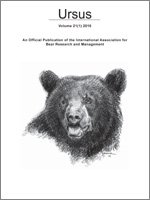Since 1990, increases in American black bear (Ursus americanus) population and distribution in the Lower Peninsula of Michigan, USA, have led to positive trends in black bear harvests, sightings, and nuisance reports. Policy makers and wildlife managers can prepare for the difficult task of managing future bear–human interactions by using resource selection models to assess bear habitat selection and predict future bear range expansion. We modeled habitat selection by black bears in the northern Lower Peninsula of Michigan using 6 environmental variables based on radiotelemetry locations from 1991–2000 for 20 males and 35 females. We developed Bayesian random effects discrete-choice models for males and females separately to estimate probability of bear selection of grid cells at 3 spatial resolutions (1 km2, 4 km2, 9 km2). These models weight individual bears and their relocations, allowing inference about both individual and population-level selection characteristics. We assessed goodness-of-fit of individual models using a Bayesian P value that estimated deviance between a simulated dataset and the observed dataset. Models for males at the 9-km2 resolution and for females at 4-km2 resolution fit our data better than others; both indicated that locations of bears were negatively associated with water, small and medium roads, mean patch size, patch size coefficient of variation, edge density, developed land-use, and non-forested wetlands, and positively associated with Shannon's diversity index, aspen (Populus spp.), and forested wetlands. Furthermore, the variability in selection by individual female bears for non-forested wetland and individual male bears for agriculture was large relative to the variability in selection of other land-use or land-cover types. Male bears had more heterogeneity with respect to selection of land-use or land-cover types than female bears. There were significant correlations between male bear age and their respective selection parameter estimates for small roads, medium roads, and developed land-use. Running Bayesian random effects discrete-choice models at multiple resolutions accounted for variability due to unequal sample sizes and bear behavior, and demonstrate the utility of the Bayesian framework for bear management purposes.
How to translate text using browser tools
1 January 2010
American black bear habitat selection in northern Lower Peninsula, Michigan, USA, using discrete-choice modeling
Neil H. Carter,
Daniel G. Brown,
Dwayne R. Etter,
Larry G. Visser
ACCESS THE FULL ARTICLE

Ursus
Vol. 21 • No. 1
January 2010
Vol. 21 • No. 1
January 2010
American black bear
Bayesian
discrete-choice
habitat modeling
habitat selection
Michigan
northern Lower Peninsula




